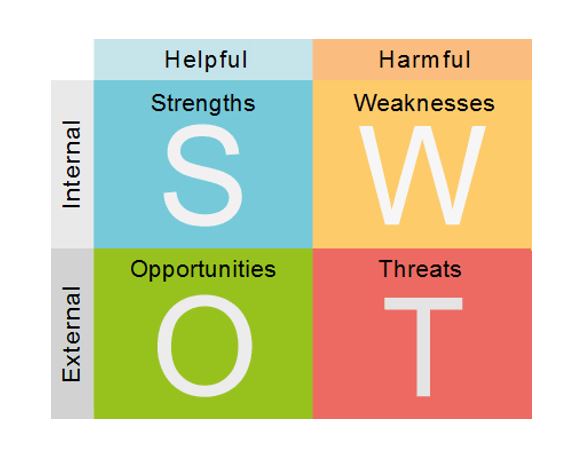There are different tools which can be used in the process of developing a strategy. Brewer et al. (2015, 5f) say that it is crucially important for a strategic plan to be based on the best available data, to consider the history of an institution and the environment in which an institution works, and to take into consideration the unique attributes of an institution, areas in need of improvement as well as opportunities and potential obstacles. A suitable tool for carrying out an analysis of these aspects is the SWOT model – SWOT standing for strengths, weaknesses, opportunities and threats.
SWOT analysis
A SWOT analysis is only possible if you have in-depth knowledge of the internal environment and a clear understanding of the university’s mission and vision. During a SWOT analysis, the strengths and weaknesses of the university and the opportunities and threats of the environment with regard to the goals in the vision are listed and assessed. This exercise should be done by representatives of different stakeholders in the university, since they bring in different perspectives. A SWOT analysis, if done correctly, promotes the use of an institution’s strengths in a constructive and effective way given the trends and influences in its environment. It is of crucial importance to understand the exact meaning of the four core elements of the SWOT analysis.
Strengths
Agents, factors or forces that are helpful for achieving the long-term objectives of the university and that can be controlled by the university.
Weaknesses
Agents, factors or forces that are harmful to achieving the long-term objectives of the university, but which can be controlled by the university.
Opportunities
Agents, factors or forces in an organization’s external environment that can be directly or indirectly helpful in achieving the long-term objectives of the university, but which cannot be controlled by the university.
Threats
Agents, factors or forces in an organization’s external environment that can be directly or indirectly harmful to achieving the long-term objectives of the university and that cannot be controlled by the university.

How to perform an analysis?
It is recommended to involve stakeholders from various levels in your university when doing a SWOT analysis in order to promote input from different perspectives. You might even think about involving students and partner universities, as they tend to have a less biased and/or interest-motivated view. A common procedure is first to create a long list of items for each category, then have an open discussion of these items, merge and categorize them, and prioritize the three or four most important ones for each category. Before you can do this exercise, it is crucial that you have proper knowledge of the trends and developments in the environment and of your own university and its culture. Furthermore, it is crucial that the participants have an open, objective attitude towards the exercise in order to avoid answers which may be intended to please the leadership rather than to reflect the actual situation. This is especially important when prioritizing the items for the ‘weaknesses’ category.
What’s next?
Once you have established a list of three or four prioritized items for each category, you need to come up with actions or measures you can take for each of the items:
• For each strength you ask yourself the question: What can we do to use and further improve on this strength in order to achieve our strategic goal?
• For each weakness you ask yourself the question: What can we do to improve on this weakness so that it will not prevent us from achieving our strategic goal?
• For each opportunity you ask yourself the question: What can we do to exploit this opportunity in order to achieve our strategic goal?
• For each threat you ask yourself the question: What can we do to cope with this threat so that it will not prevent us from achieving our strategic goal?
Remember that you can change strengths and weaknesses, but not the opportunities and threats. There are techniques to combine internal and external elements in your questions, e.g. How can we use this strength to exploit this opportunity? This helps you relate your university to its environment, which will lead to more effective actions.
A tool for using and analyzing the results of the SWOT analysis in more depth is the ‘confrontation matrix’. This tool, which is frequently used in marketing, requires the participation of a group of people. Each of the participants is asked to prioritize the different options identified through the SWOT analysis in a matrix by assigning scores. Merging the scores assigned by the different participants shows which options have been assigned the highest scores. In this way, a group of people collectively decide which options are strategically most important to the institution and should therefore be given particular attention. Once the priorities have been identified, you can start creating a work plan which details actions, allocates resources, indicates responsible units, etc. (see, for example, https://expertprogrammanagement.com/2011/08/the-confrontation-matrix/).
Download the SWOT template (word)
References
• Strategic Planning for Internationalization in Higher Education
Elizabeth Brewer, Harvey Charles, and Adelaide Ferguson; contributions from Susan Carvalho and Joanna Regulska
AIEA OCCASIONAL PAPERS, February 2015
https://aiea.memberclicks.net/assets/docs/Issue_Briefs/aiea_issuebrief_2013sept-%20op.pdf (accessed 12.04.2018)
• The Confrontation Matrix
Expert Program Management
https://expertprogrammanagement.com/2011/08/the-confrontation-matrix/ (accessed 01.08.2018)


